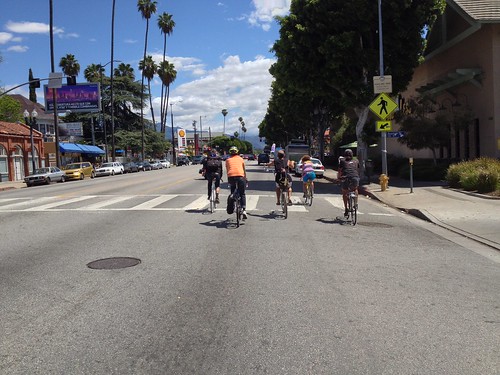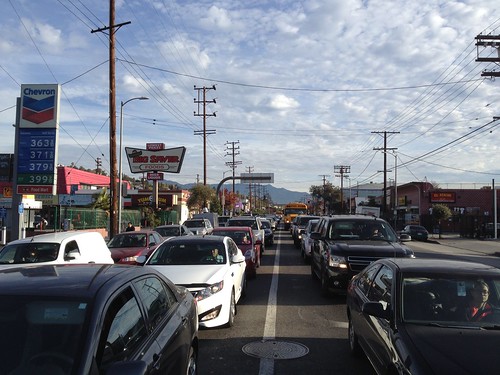November 4, 2009 LA Bike Plan Meeting – 1st Edit from Arthur Schlenger on Vimeo.
The people of North East Los Angeles have lined up in public comment queues for half a decade now to speak out in favor, or opposition, to bike lanes on North Figueroa Street. Most of us in favor of the bike lanes imagined that, if we could only share the lessons learned in other parts of Los Angeles (and the world) about the improved safety, human health, happiness, and business prospects that can come with a proper connected urban bike lane project that surely we would fare well in City Hall.
During the last term of Councilman Ed Reyes that seemed to have worked. Since the 2013 election of Gil Cedillo, our techniques to incite change have not worked. Is there a way to get the North Figueroa Street road diet going again?
The bike lane on North Figueroa Street was included in the 2010 Bike Plan. The project passed through the gates of a full Environmental Impact Report and emerged with a city council vote adopting the report. Money was moved from Measure R sales tax dollars into a special bike project fund for North Figueroa.
There is a cancer at the heart of Los Angeles’ bike plan, like there is a cancer at the heart of every plan that passes through the city council in Los Angeles.
The cancer I am talking about reminds me of the old improv comedy show “Whose Line Is It Anyway?” which always began with the phrase: “The show where everything’s made up, and the points don’t matter.”
The cancer in LA’s bike plan is this: it isn’t law. If an individual city councilmember, e.g. Gil Cedillo, doesn’t like a part of the plan that the full council approved, or doesn’t like the way a department is implementing a plan the full council approved, that individual councilmember can order all work on that portion of the plan to be stopped.
This flies in the face of the City of Los Angeles’ Charter, Section 242. Conduct of Business (b) which states:
"The Council, by ordinance or resolution, shall establish a sufficient number of committees to enable it to carry out its duties. The duty of the Council and its committees is to become fully informed of the business of the City so as to oversee all the functions of the City government, and to report to the Council any information or recommendations necessary to enable the Council to properly legislate. Committees shall have the power of investigation, but shall have no administrative control over the various functions of the City government. The administration of the City government shall be vested in the officials designated in the Charter to perform those functions[.]"
The full council has the power to pass ordinances "[u]pon any subject of municipal control, or to carry into effect any of the powers of the City." (Los Angeles Administrative Code, Section 2.14.)
How can one individual councilmember stop parts of a plan approved by the full city council? What are the powers of an individual councilmember in Los Angeles? As far as I can tell the full council is vested with all sorts of fancy powers and rights. Individual councilmembers, however, have no real power … and yet the road diet on North Figueroa Street appears to be cancelled.
The game is made up and the rules don’t matter.
Gil Cedillo has no statutory power to stop the LADOT from installing a road diet on North Figueroa Street. The LADOT doesn’t legally need to stop work at Cedillo’s request – so why have they stopped working on the North Figueroa Street road diet?
In Los Angeles, if a department messes with one council office they risk messing with the whole council. This city sprawled so far beyond its ability to maintain itself two generations ago that getting a sidewalk paved, water main fixed, trees trimmed, or street swept requires some sort of influence peddling at election time by those smart enough to get connected with a local councilman’s office. Elected in off-year, low-turnout, elections; councilmen face no serious electoral challenges (barring scandal) if they dole out the limited number of favors they can afford to their election year supporters.
In order to trade in favors in a chronically unmaintainable mess of a city, councilmembers allow each other to wave full council action in front of departments working on small enough projects contained mostly within their districts.
“Do what I want or we’re going to go after you in the budget next year.”
“Build that portion of your project in my district and the council is going to make your job, specifically, illegal within Los Angeles city limits.”
It never needs to gets to this level these days. The system is so formalized that city departments send their envoys to lie and cajole council offices, bribe them with give-aways to the recipients of the councilmembers choice, and come away with the informal approval of any project a city department wants to build. When things break down, like they have with the road diet on North Figueroa Street and Councilman Gil Cedillo, the department backs down and waits either for a groundswell of support (Ahem! Cough! Figueroa For All. Cough!) or simply lets the project die.
Notice how none of the legal and pseudo-legal hurdles most of us local politics junkies talk about matter here? We’re not even talking about legal powers of the council offices anymore – we’re talking about a game-theory of local governance in Los Angeles.
It is a game – except, unlike “Whose Line Is It Anyway?”, our lives are at stake, our health and happiness is on the line. Unlike the improv TV show, the points do matter in local politics. Either we get a safer street or we keep a stupidly designed status quo stroad.
How do we win this game?
Gil Cedillo raised $2.1 million in his bid to become a city councilman. He spent, combined with so-called independent expenditures, about $200 per vote in the general election that saw him squeak by his opponent with a margin of less than 800 votes. There are nearly 82,000 registered voters in Council District 1 out of about 250,000 residents. Cedillo was elected by 10,152 voters. His opponent lost with 9,389 votes and only spent half the amount of money Cedillo did.
We can’t afford to buy ads on the size and scale Cedillo can. We can’t afford to use campaign cash and city council money, robocall machines, and staff time to advertise our point of view the way Cedillo has.
What we can do is come together, as we have for years now, and agitate for change within our community. Our bike rides, our parties, our parade entries, walking tours, secret stair climbs, protest marches, petition gathering surveys, tabling of large public events, attending community meetings, voting in Neighborhood Council election – it all adds up.
Combined with the efforts of the Los Angeles County Bicycle Coalition, Figueroa For All has directly touched the lives thousands of real people in NELA. These are people who have participated in an event or signed a petition for the North Figueroa Street road diet (probably both!). We have done it with no campaign funds, no independent expenditures. Despite or $0 budget, the number of people signing the petition in favor of a Figueroa For All grows by the day. For example, on a normal business day I get 5 to 10 signatures on the petition I leave out on the counter of the Flying Pigeon LA shop.
Every cell phone number and email address is potentially another real person in the community who will walk, bike, and vote with us on street safety measures and candidates. It costs us $0 and our movement grows itself.

Councilman Cedillo stalked by Reverend Fig4All at a Latin Jazz Festival on August 23, 2014. The Rev.’s sign reads “REPENT CEDILLO”. Photo by Martha Benedict.
Cedillo, like most candidates who’ve won election in Council District 1 in recent history, ignored the most significant public safety issue facing his district: unsafe streets for walking and bicycling. He has nobody on his staff of 20+ who has passed even an introductory course in urban planning, civil engineering, or design. He is flying blind, pulling counter-arguments out of thin air.
He is scared. He picked a political fight with a group of people who, in fighting for a road diet don’t get burned out – we actually get stronger, feel better, and enjoy our lives more when we come together to celebrate our dreams for a safer, more humane, community.
Whose law is it anyway? It is the law of the American political jungle. Don’t let Cedillo’s spite and apprehension with the 21st century slow us down! Get together! Have fun!
We’re planning a big pedestrian and bicycling festival in November and December. Keep your eyes peeled for a 30-day, crowd-sourced, free, livable streets festival called Si Se Mueve. If you want to get involved in the Figueroa For All campaign leave a comment below and we’ll add you to our email list, join our Facebook group, or sign the LACBC’s change.org petition for a North Figueroa Street road diet.





















